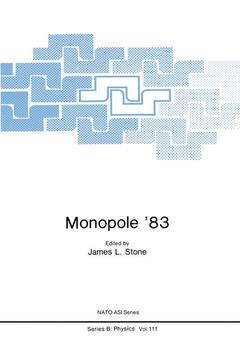Monopole '83, Softcover reprint of the original 1st ed. 1984 NATO Science Series B: Series, Vol. 111
Langue : Anglais
Auteur : Stone James L.

Ten years have passed since It Hooft and Polyakov demonstrat ed that superheavy magnetic monopoles were a natural consequence of any Grand Unified Theory (GUT) in which the unifying group contains a U(l) factor as a subgroup. An analysis of these GUTs in an expanding, cooling universe yields a phase transition at an energy ~l015 GeV and at a cosmic time ~lO-35 seconds after the big bang. The general consequences of GUTs and this phase transition are the prediction of proton decay, the production of superheavy magnetic monopoles, and an understanding of the observed excess of matter over anti-matter in the universe. Attempts to provide experimental verification of GUTs has led to valiant experimental efforts in recent years to observe nucleon decay in massive underground detectors. Experiments to search for superheavy monopoles may eventually require similar efforts. Since the unification scale is unreachable in the laboratory, monopole detectors must search for relics of the big bang. Much theoretical groundwork has been accomplished in recent years with the development of GUTs. In Part I of this book, Erick Weinberg gives a theoretical overview of the role of magnetic monopoles in the various unification schemes. Monopoles in the context of the newly revived Kaluza-Klein theories are presented by several authors and are summarized by Qaisar Shafi. Mike Turner begins Part II with a discussion of monopoles in standard big bang cosmology. Paul Steinhardt follows with his perspectives on the inflationary universe; C.
I: Monopoles and Particle Theories.- Monopoles and Grand Unification.- Nonabelian Monopoles Break Color.- The Scales and Upper Bounds of Classical Monopole Solutions.- Kaluza-Klein Theories and the Dirac Monopole.- A 5-Dimensional Monopole.- Magnetic Monopoles in Grand Unified and Kaluza-Klein Theories.- Black Holes in Compactified Supergravity.- Magnetic Monopoles in Purely Fermionic Models.- Summary of Discussion on GUTs and Kaluza-Klein Theories.- II: Monopoles and Astrophysics.- Superheavy Magnetic Monopoles and the Standard Cosmology.- Progress and Prospects for the Inflationary Universe.- Primordial Inflation and the Monopole Problem.- Kaluza-Klein Cosmology.- Galactic Magnetic Fields and Magnetic Monopoles.- Neutron Star Physics and Monopole Flux Limits.- Monopoles in Pulsar PSR 1929+10.- Monopole Contamination of Normal Sequence Stars.- Magnetic Monopoles in a Magnetic Universe.- III: Monopole Catalysis of Nucleon Decay.- Catalysis Without Tears.- Conservation Laws in the Monopole-Fermion System.- Monopoles with Zn Charges.- Interactions of Fermions with Spherically Symmetric Monopoles.- On the QFT of Monopole Induced Baryon Number Violating Processes Including Non-Abelian Forces.- A Friedel Sum Rule for the Dyon Charge.- Monopole Catalysis: An Overview.- Monopole Catalyzed Nucleon Decay: The Astrophysical Connection.- Experimental Limits on Monopole Catalysis of Nucleon Decay.- IV: Monopole Interaction Mechanisms.- Excitation of Simple Atoms by Slow Magnetic Monopoles.- The Coupling Between Magnetic Charges and Magnetic Moments.- Binding of Nuclei to Monopoles.- Vacuum Anti-Shielding of Monopoles.- Monoponucleosis-The Wonderful Things That Monopoles Can Do To Nuclei If They Are There.- Coherent, Co-operative Aspects of Monopole and Matter Interaction.- V: Monopole Detection Techniques.- The Physics of Monopole Detection.- A Search for GUT Monopoles with Mica Track Etch Detectors.- On the Feasibility of Infrared Phosphors in Super-Slow Particle Searches.- A Study of Acoustic Detectability of Magnetic Monopoles.- The Caltech Prototype Scintillator Monopole Detector.- Detectors for Rare Events.- Neutrino Oscillations and Neutrino Astronomy in a Large Flat Detector.- VI: Induction Techniques and Experiments.- Report on Stanford Superconductive Monopole Detectors.- Monopole Search at IBM: Present Status and Future Plans.- First Results from the Chicago-Fermilab-Michigan Cosmic Ray Magnetic Monopole Detector.- The Imperial College Monopole Detector.- Monopole Detector Studies at NBS.- Zero-Quantum Superconducting Magnetic Shield.- The Straight Wire Monopole Detector.- Noise Considerations in a “Room Temperature” Induction Technique Magnetic Monopole Detector.- Squid Fluxmeter Search for Monopoles in 400 kg of Old Iron Ore.- A Detector for Relic Monopoles Trapped in Magnetic Ores.- A Summary of Induction Detectors and Techniques.- VII: Ionization/Excitation Experiments.- A Search for GUT Monopoles with a Single Thick Scintillator at Sea Level.- Use of Large Volume Liquid Scintillator for Monopole Detection.- Monopole Search and Neutrino Astrophysics with Liquid Scintillation Detectors.- Status of the Texas A & M GUT Monopole Search.- A Scintillator-Proportional Counter Search For Monopoles.- Monopole Flux Limits from the Soudan I Experiment.- A Search for Magnetic Monopoles in the Mont Blanc Nucleon Decay Apparatus.- Monopole Search with the Frejus Tunnel Nucleon Lifetime Experiment.- A Monopole Search Using an Accelerator Detector.- Experimental Searches for Magnetic Monopoles at Particle Colliders.- Ionization Detector for Cabrera’s Monopole Experiments.- Review of Monopole Detection by Ionization/Excitation Techniques.- VIII: Conference Highlights and Summation.- Experimental Situation.- Monopoles in 1983.- Participants.
Date de parution : 06-2012
Ouvrage de 699 p.
17.8x25.4 cm
Disponible chez l'éditeur (délai d'approvisionnement : 15 jours).
Prix indicatif 52,74 €
Ajouter au panierThème de Monopole '83 :
Mots-clés :
astronomy; astrophysics; atoms; cosmic ray; cosmology; energy; experiment; fields; neutron; noise; nucleon; oscillation; physics; star; universe
© 2024 LAVOISIER S.A.S.


